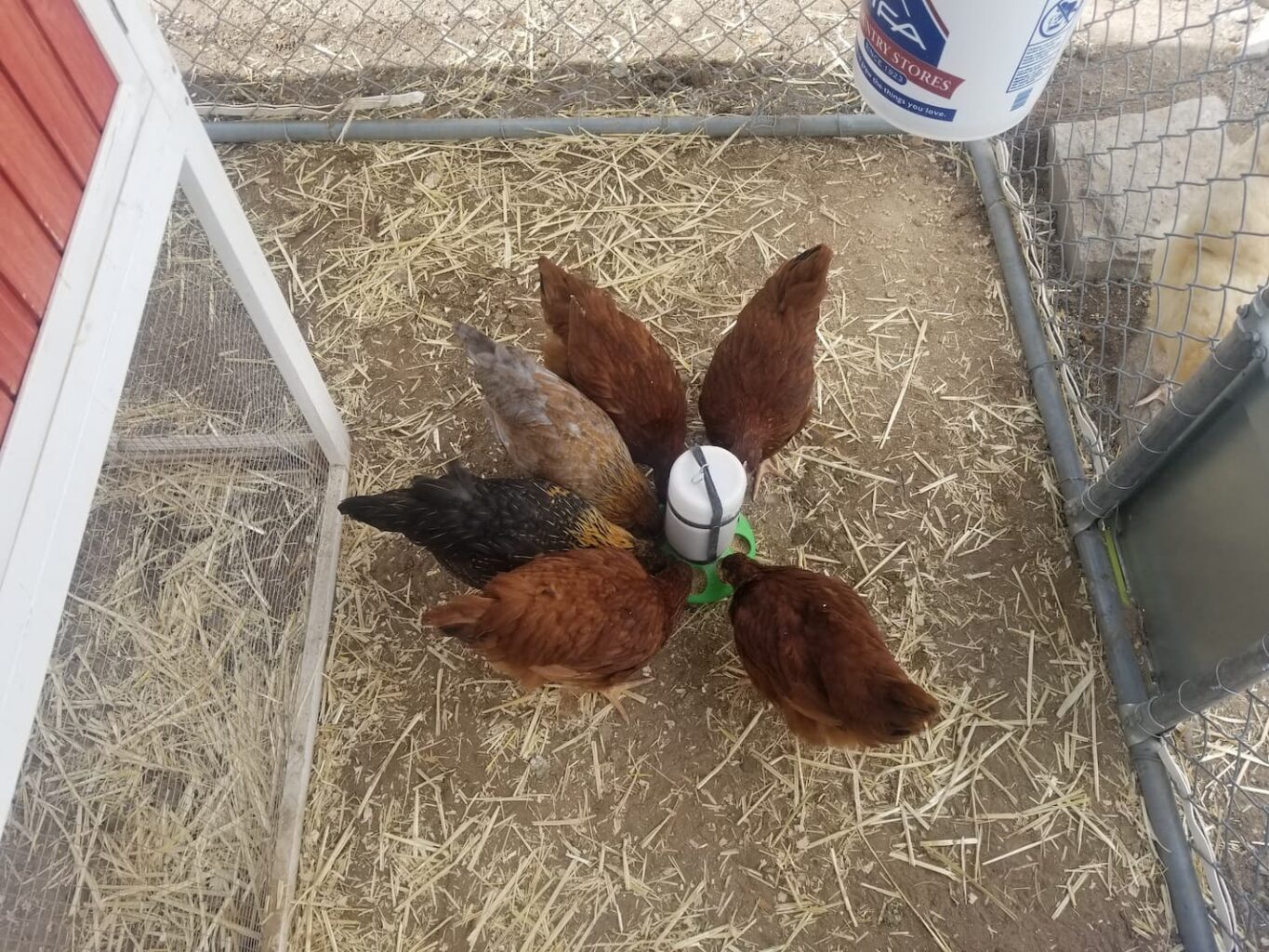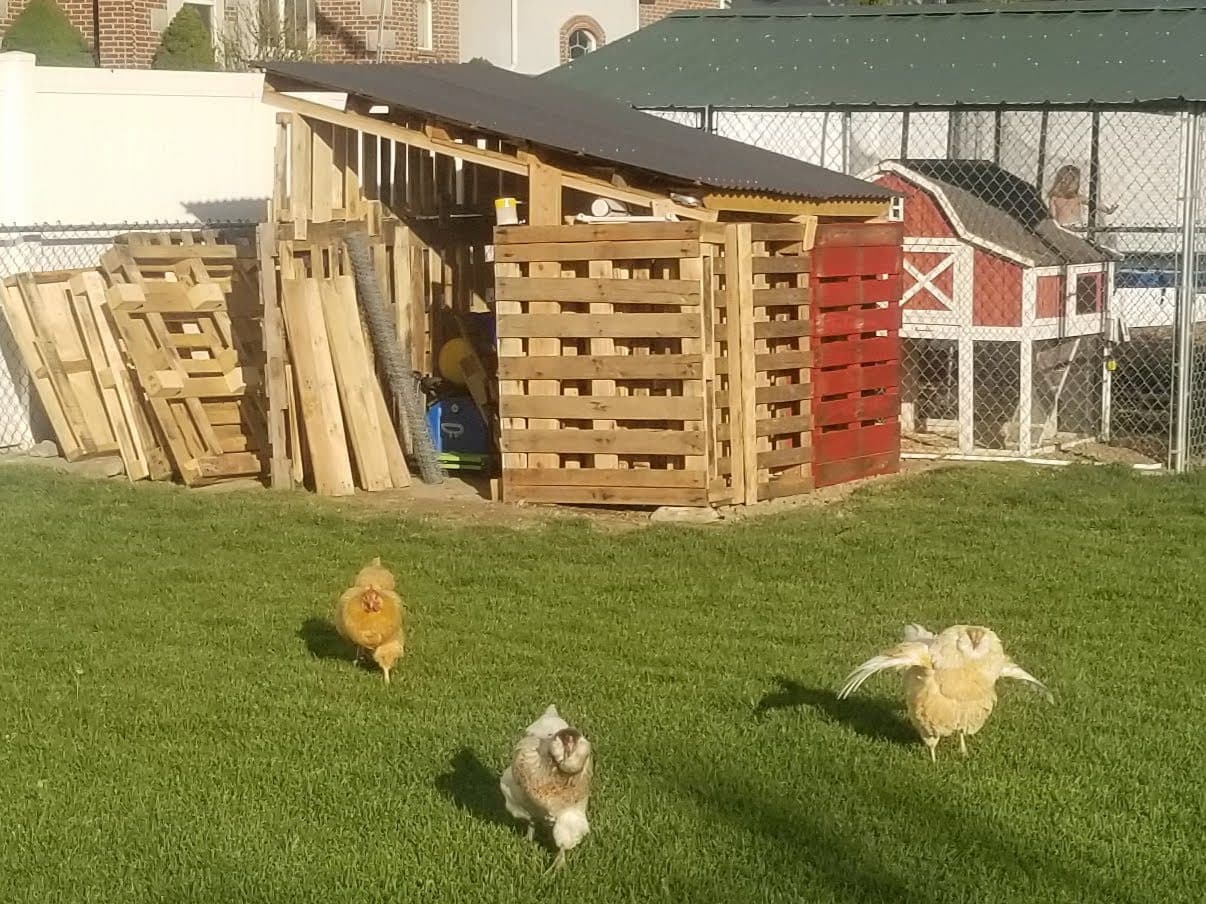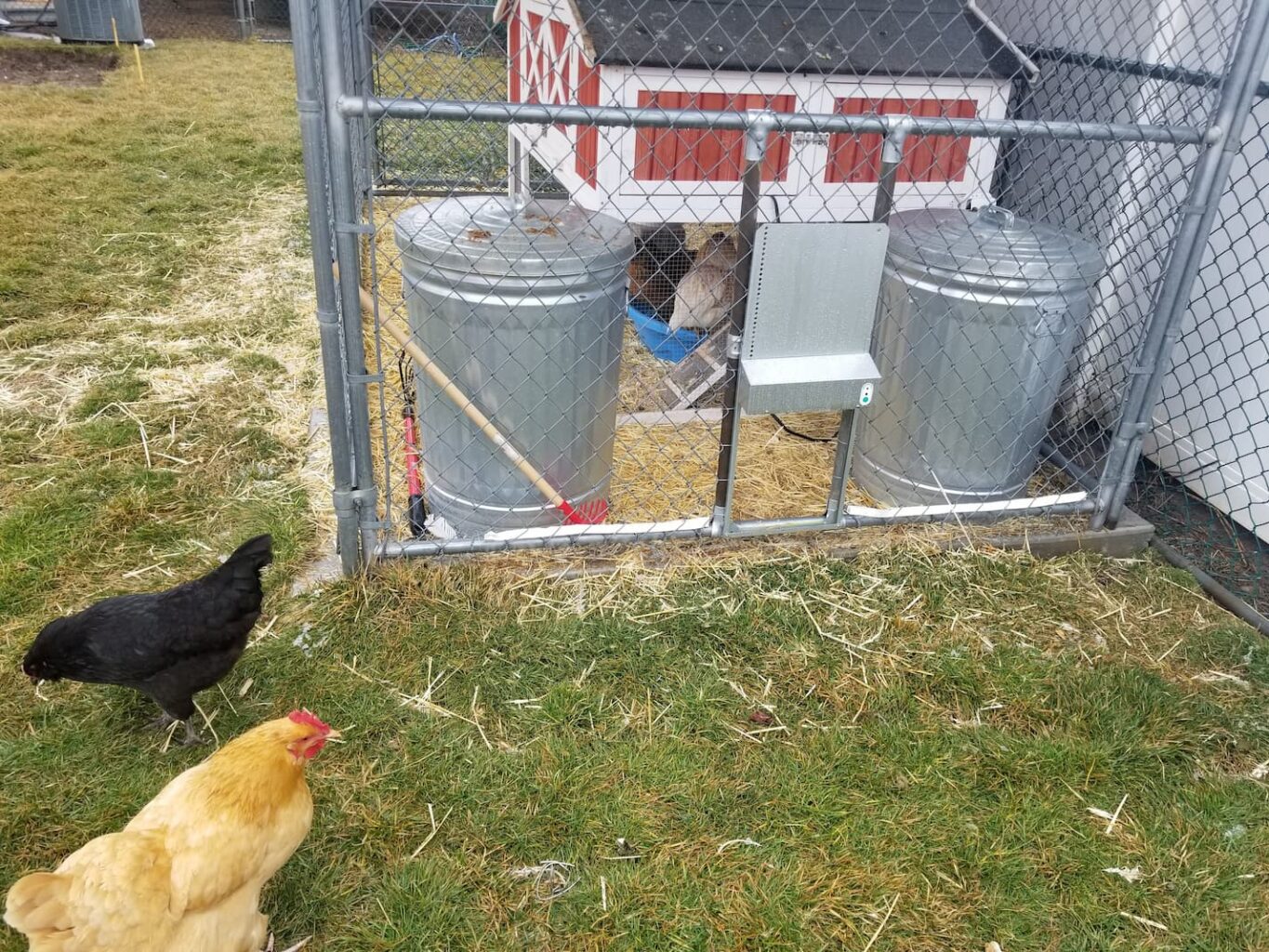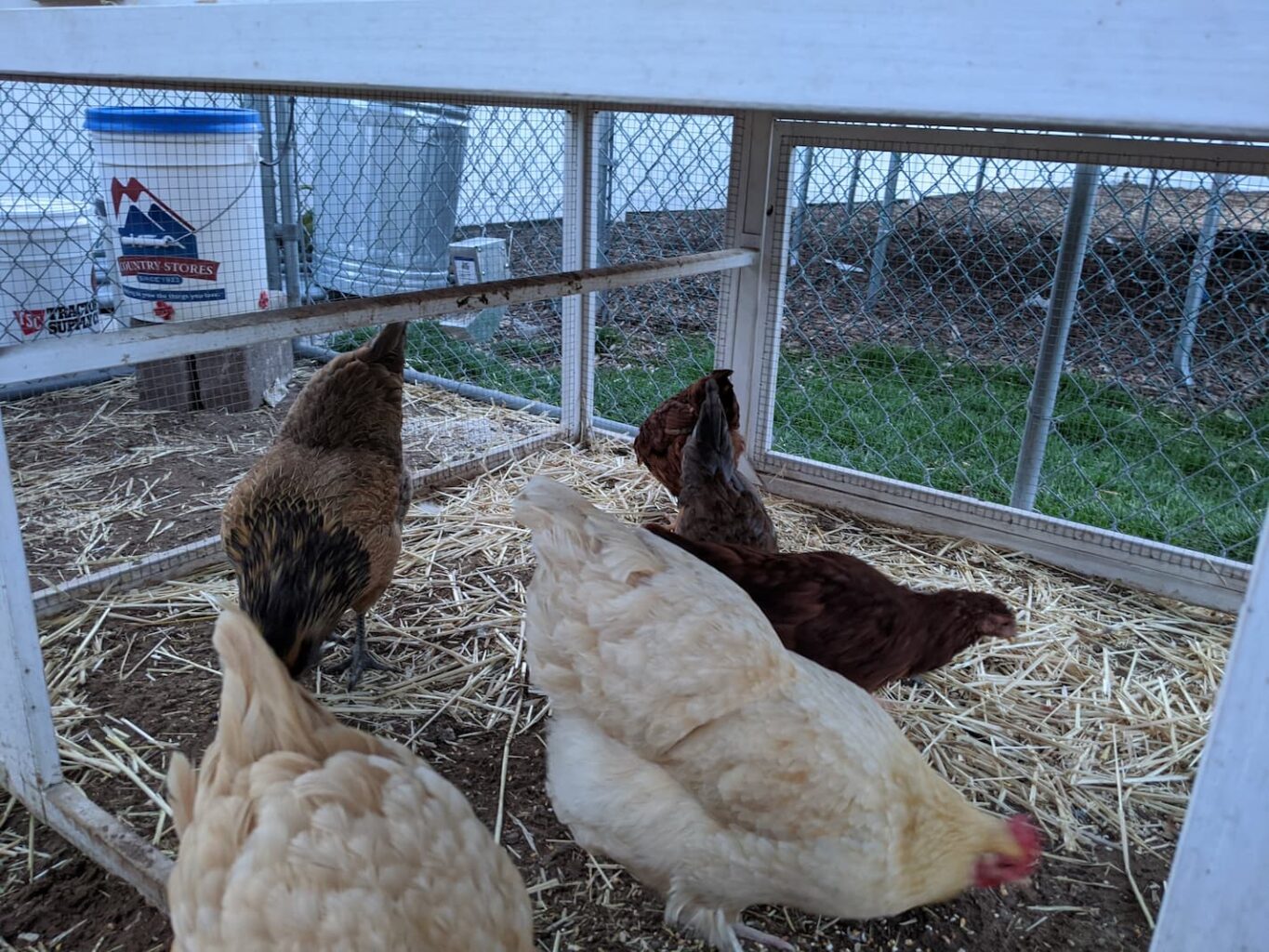We all want the best for our chickens, but when it comes to the floor of their coop, how do you what’s the best ground cover? With so many choices out there, it can be difficult to know what to put that’s healthy for your chickens, economical, simple, and easy to clean. Here’s what you need to know about why you need a floor, and how to get the most suitable option for your chickens.
In general, the best ground cover for a chicken run is anything that keeps the ground dry, safe, and comfortable for chickens while also being easy to clean as needed. Bedding material, sand, solid floors, and landscape mulches are popular options for running floors alone or used together.
Ready to compare all the different possibilities? Let’s do this. And at the end of the article, I’ll tell you exactly what we use.

What’s the best surface for a chicken run?
In reality, you may find that the best solution for you is some kind of mix of these surfaces. Many people begin with a hard, easily drained, and easily cleaned surface (such as concrete or gravel) upon which they place a softer, more chicken foot-friendly surface on top of, like sand or deep litter.
The best surface for you will be whichever solution is cost-effective but also keeps your chickens clean, safe, and dry.
It’s easy to see that mud floors are bad (more on this later), but it’s much harder to work out the most suitable floor for your chickens. Some floors are best suited to certain climates and conditions; others may be low maintenance but expensive options.
Of course, it’s best to bear in mind the comfort and enjoyment of your chickens when you choose the surface of your chicken run.
What to put on the ground in your chicken run
The best ground cover for the inside of your chicken run is going to depend on what you’ve got, your environment, local weather patterns, and how many chickens you’ve got. But this table can show you a quick look at the pros and cons of the most popular ground cover types.
| Groundcover | Pros | Cons |
|---|---|---|
| Concrete | Solid barrier Predator safety Easy to clean Durable Low maintenance Cool in hot weather (usually) | Can be too cold if in a cool climate Boring for the chickens, and can cause injury (like bumblefoot) Expensive Permanent |
| Deep Litter Method | Only needs changing once per year Cheap (may even be free!) | – It’s important to mix and add layers regularly to maintain good hygiene |
| Grass/Vegetation | Chickens can forage insects/worms Good nutrition means tasty eggs! Good enrichment for chickens | Chickens will scratch the grass and waste it. Best for movable coops (tractors/arks) Grass will need to be reseeded |
| Sand | Simple Cheap Dries manure for collection Easy to see dark manure against light-colored sand Makes composting simple | Requires regular poop scooping (as often as daily) Less suitable in wet climates Needs suitable drainage |
| Wooden floors | Easy to get materials Cheap Easy to build | Difficult to clean Might need extra treatment or covers (like paint) Needs to be well-made to prevent predators Might decay with age Needs bedding |
Now let’s go into each of the run flooring types so that you can get a better overall picture of what you should choose. And at the end? I’ll show you exactly what we use.
Concrete floors
If money isn’t an object and you have a permanent location for your chicken coop, concrete can be a solid option (pun very much intended). It’s a durable surface, which will keep predators out and can be easily cleaned, for example with a hose or pressure washer.
However, as it has cooling properties, it may be less suitable in climates that often become cold. You will also need to provide your chickens with soft bedding to prevent injury and to offer them space to forage as they can become bored on the hard surface.
Installing a concrete floor is likely the most expensive option, but also one of the easiest to manage once installed.
But if you’ve already got a concrete pad in place? It’s an awesome option. If you’ve got an old shed you won’t be using, look under it. You may already have a concrete pad you can use.
The Deep Litter Method
The Deep Litter Method (DLM) is a popular option among chicken owners. It involves placing a soft surface, such as pine shavings or straw, over the floor. It can be used in the coop and/or the run.
When the litter becomes more soiled, you simply add another layer and stir to mix them up. This provides easy sanitation with very little effort as other than adding the new layers, the floor will only need to be fully replaced around once per year.
It’s also very affordable, and some owners even manage to collect pine chips free of charge from local forestry companies.
If you can’t get free wood shavings or chips from your local forestry company, be sure to buy them from the equine section of your local feed store. They’re available in bulk – and at much better prices than the pet store or small animal section of the stores.
Grass and Vegetation
Of course, it’s also an option to keep your chickens more au naturel. If you have a movable coop (known as a chicken tractor or ark), this can be a great option. Not only is it cheap and low maintenance, but it will keep your chickens happy, offering them the chance to peck for insects and worms. The good nutrition this gives them leads to delicious eggs!
Pro tip: it is important to move the coop regularly, as when chickens scratch the ground they destroy it quickly, turning it into mud. In general, you may want to move your tractor every day. Doing this should minimize how much reseeding you need to do. Your chickens will eat back the grass, but shouldn’t destroy it within a single day.
If you can’t move the tractor every day, that’s okay. You’ll just have some mud. The mud will need to be reseeded so that you can eventually move your coop back to the same place once the grass grows back.
Grass floors don’t offer protection against predators digging into the coop, which can be done with a wire floor. These can be a good, protective option that still maintains ventilation and allows the manure to fall from the coop.
However, it requires the right kind of wire — normal chicken wire can be easily bitten through by most medium-size predators. So if you have lots of medium-or larger-sized predators, go for a stronger hardware cloth or heavy-duty welded wire.
Sand
Another popular option is to floor your chicken coop with sand. Sand is a simple, cheap, and easy-to-clean option.
Dark chicken manure shows up easily against the brighter colored surface, so you can simply scoop it away. If you like to use your manure as compost, this may be a good option for you as you can easily collect this.
However, the downside to sand is this: to make sure the coop is clean, it will require daily cleaning.
Sand also quickly becomes damp, so if you live in a very wet climate it can be less suitable. Even in dry climates, it is important to ensure that the sand has adequate drainage.
In hotter climates (like my home state of Arizona), and is the defacto choice. However, it can get too hot for chicken. So it will need some kind of cooling bedding or to be sprayed down.
Wooden floors
Wooden floors are almost a whole other list by themselves, as there are many different types of wood and surfaces to choose from.
In general, the benefits of a wooden floor are that it’s easy to get hold of the materials, cheap, and a simple DIY fix. However, depending on your exact build, it may be difficult to clean or might decay with age. If you’re using a deep litter method, though, then the wood floor should hold up in general.
Local humidity levels will be the determining factor for the floor’s life expectancy.
Some people use extra surfaces on top of the wood (such as paint or vinyl) to smooth cracks, making the surface easier to clean with a hose or pressure washer. Bear in mind that, like concrete, a wooden floor alone isn’t an adequate floor for your coop. You’ll need to provide bedding to keep your chickens nice and comfy.
Is mud bad for chickens?
The short answer to whether a mud floor is bad for chickens is YES.
When a chicken coop has a muddy floor, it can be a big problem. It’s not just that you have to pick up muddy eggs, but your poor chickens can find it difficult to walk. It can also be a factor in causing serious health issues such as bumblefoot and parasites.
Mud floors are also less protective against rodents and other predators than alternative floors. For these reasons, chicken owners are generally recommended to provide some cover for the ground of their chicken run.
Want to read more about muddy chicken runs? Read my complete guide to fixing muddy coops and runs here.
Should chicken runs be covered?
It’s definitely a good idea to cover your chicken run with a roof. Not only does it provide cover from many predators, but it keeps out the rain and snow, which will help prevent those annoying drainage issues.
As chicks grow to full size, they will learn to fly even up to six feet — so a roof will keep your beloved feathered friends safe, dry, and secure.
Final thoughts on run floors (and what we do!)
We’ve got a half-acre lot, so our chickens get treated like poultry royalty. They’ve got a large coop (we do have 12 chickens), a covered run, and access to a pasture for free-range foraging. The covered run has a little chicken-sized door that lets them out.
Or, if it’s rainy, they just hang out in the coop and covered run. These images show the old coop – the new one is about 3 times larger than the old one. But they show you the various flooring we use in outdoor runs.
We rely on a lot of straw, sand (under the straw), and our covered run to keep the chicken’s outdoor flooring dry. Inside the coop, we use a deep litter method with pine shavings.



It doesn’t have to be chicken rocket science. But it does need to be well-thought-out. Want to see our new coop? I’ve got a whole video reveal on the YouTube channel. You can check it out (and subscribe) here.
Resources
Learning from your own experience is essential, but learning from others is also intelligent. These are the sources used in this article and our research to be more informed as homesteaders.
- Starr, Kimberly. “Is Your Chicken Coop Muddy? Here’s What to Do.” Backyard Homestead HQ, Backyard Homestead HQ, 6 Mar. 2020, backyardhomesteadhq.com/is-your-chicken-coop-muddy-heres-what-to-do/.
- What Would Be the Best Ground Cover for a Chicken Run. 26 May 2017, www.backyardchickens.com/threads/what-would-be-the-best-ground-cover-for-a-chicken-run.344222/.